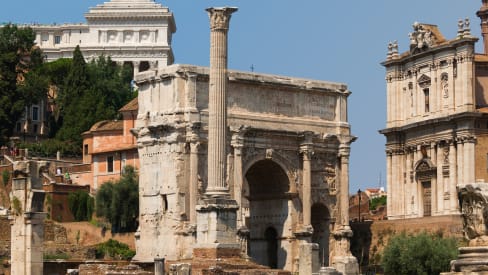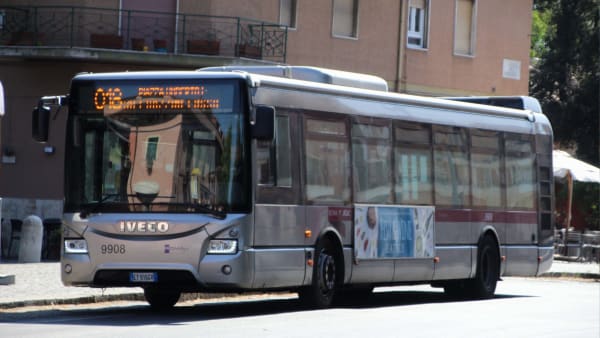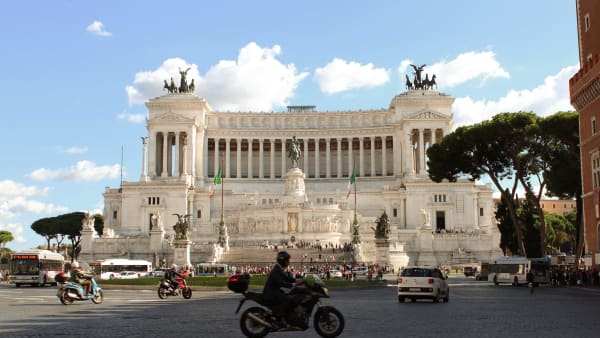Curiosities
Curiosities
Now that you know more about the history of the Forum and its main monuments and buildings, here’s a list of curiosities. Discover, for instance, how the Forum Romanum got its name, why a hugely popular festival was celebrated there every year, and what macabre performances took place at the site.
The origin of the name
Originally, the word “forum” was used to refer to the space around a house or a tomb. Later, the word was used to designate the political, religious, commercial, administrative, and cultural center of the city.
According to other sources, the origin of the Forum Romanum is derived from Latin, meaning “Roman market square.” This refers to the original function of the archaeological site where goods were brought to be sold.
The legend connecting Romulus and the Lapis Niger
The writer Pliny the Elder tells us that three sacred trees (a fig tree, a vine, and an olive tree) dominated the square at the center of the Forum.
According to the legend of Roman mythology, the twin brothers Romulus (founder of Rome and first emperor) and Remus, after being thrown into the Tiber in a feeder, were found by the wolf Lupa Capitolina and fed under the fig tree. Today, these trees have been replanted to commemorate the memory of this legend at the oldest site in the Forum, the Lapis Niger.
As mentioned in the historical section of this article, in later times the Romans thought that this sanctuary was the place where Romulus was killed and buried. For this reason, we can assume that the ancient stone inscription was meant to curse possible desecrators and protect the tomb of the founder of the Eternal City.
The Saturnalia
The Saturnalia was a Roman pagan festival. It was first celebrated on December 17, 497 BC, during the inauguration of the Temple of Saturn (the Roman god agriculture). The rituals during the festivities were somewhat similar to what we know today as Christmas and Carnival.
During the festival, a large public banquet was organized and people sang, feasted, ate, and gambled. They also gave each other gifts such as candles, dolls, and masks. In the temple of Saturn, where an ivory statue of the god stood, a rope was tied around the feet all year round—which was loosened during the celebration so the god could join the great banquet.
Another notable ritual is that during the banquet, the roles of slaves and their masters were reversed. The slaves were allowed to dress up and were served by their masters. The social order was forgotten for a moment and the slaves could temporarily consider themselves free.
Originally the feast lasted one day but was gradually extended to seven days (from December 17-23).
The Vestal Virgins
As mentioned in the section about the Temple of Vesta, the Vestal Virgins were priestesses who participated in the cult of the goddess Vesta. Along with the emperor, they had exclusive access to the temple of Vesta, located on the Roman Forum.
They were responsible for keeping the sacred fire burning, which was never allowed to go out. In addition, they also had the task of collecting water from the sacred spring of the nymph Egeria, which was used for the cleansing of the temple.
The priestesses lived in the Vestal House and actively participated in the life of the capital and led a comfortable life, thanks to private donations and bequests. They also helped the poor and weak and were able to pardon the condemned. It’s said that the first vestal was the mother of Romulus and Remus.
The six virgins were chosen by Pope Maximus from a group of twenty girls between the ages of six and ten. Originally they had to come from noble families. In addition, the priestesses had to take a vow of chastity and could only leave the cult after 30 years. If the vow was not kept, they would be buried alive and their seducer would be flogged to death.
Macabre performances
The Rostra was a place where sacrifices were made to the gods and important speeches and verdicts were delivered by orators and magistrates. However, this place had another function as well, which was very common at the time, namely the display of the mutilated bodies of defeated enemies or political rivals. It was also common that only limbs or body parts were shown.
Although this seems cruel and unimaginable today, at the time this practice served as a warning to those who wanted to turn against the Romans but also as an expression of power and political authority of the Roman Imperium.
An example of this phenomenon is the struggle for power between Cicero and Mark Antony. When Cicero lost, his severed head and hands were publicly displayed at the Forum.















